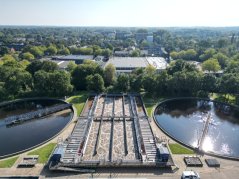
Wageningen World
Removing medicine residues from water
A new Wageningen water purification technology, developed in part by Royal HaskoningDHV, removes up to 90 percent of medicine residues from sewage. Microorganisms and ozone work together to get the job done. The first full-scale system will be built this year in Zeist.
As people live longer, the use of medication increases. This poses a growing problem for water quality. Medicine residues – including painkillers and contraceptives like the pill – enter sewage systems through urine and pass through conventional wastewater treatment plants. According to the Dutch National Institute for Public Health and the Environment (RIVM), over 190,000 kilograms of pharmaceutical substances end up in surface waters every year.
Wageningen World
Drinking water companies that use surface water are finding it increasingly difficult to remove these substances. Many of them are harmful to aquatic life. The commonly used painkiller diclofenac, for example, can damage the gills, liver, and kidneys of fish. The contraceptive pill has been shown to cause sex changes in fish, and antidepressants can alter the behavior of fish and crustaceans.
Water authorities have been developing new technologies and additional purification steps for years to tackle these persistent pollutants. One method involves adsorption onto activated carbon – a substance similar to Norit – while another breaks the contaminants into smaller, less harmful molecules using ozone. Ultraviolet light was also tested as a treatment method, but proved too energy-intensive.
New technology
About ten years ago, a Wageningen research team of PhD candidates led by Professor Huub Rijnaarts, chair of Environmental and Water Technology, began developing a new purification technology. In this approach, microorganisms form a biofilm on activated carbon and break down the more easily degradable medicine residues.
"We noticed a whole zoo of microorganisms forming in the biofilm over time," says alumnus Arnoud de Wilt. He completed his PhD in Wageningen working on this technology and now works for consultancy firm Royal HaskoningDHV. “At first, we gave these organisms plenty of time to clean up most of the mess.”
However, the researchers had to ensure an adequate oxygen supply; without it, the microorganisms had little effect on the drug residues.
Ozon as a second step
The remaining, harder-to-degrade residues were then transferred to a small tank where ozone was added. This highly reactive form of oxygen, often referred to as "super-oxygen," breaks contaminants apart by cutting their long molecular chains.
For example, the epilepsy drug carbamazepine was not broken down by the biofilm but did degrade through chemical oxidation in the ozone reactor. “Since most of the dirty work was already done biologically, only 25 percent of the usual amount of ozone was needed,” says De Wilt.
This not only saves on costs but also prevents the formation of bromate, a potentially carcinogenic by-product of the ozone reaction. “Bromate poses no threat to aquatic ecosystems, but it can be harmful to humans if consumed,” De Wilt explains. The energy demand of the process is also significantly lower.
Engineering prize
Using biological processes in water purification is a hallmark of the Wageningen approach. Last year, the new technology – named Aurea – won De Vernufteling, an innovation prize awarded by engineering associations Koninklijke NLIngenieurs, KIVI, and the journal De Ingenieur. The award honors engineering projects with significant societal impact.
Aurea can neutralize up to 90 percent of pharmaceutical pollutants and now faces the test of real-world application. The regional water authority De Stichtse Rijnlanden is currently building a full-scale plant using this technology at the Zeist wastewater treatment facility.

A recent study by STOWA shows that several new purification techniques are now ready for implementation. “Our system scored very well,” says De Wilt.
However, not all of the 314 wastewater treatment plants in the Netherlands will adopt the Wageningen technology. “I expect a market share of 20 to 40 percent,” he adds.
Research has shown that Aurea cannot remove PFAS, one of the most pressing current contaminants. Still, De Wilt sees a role for the system as a pre-treatment step to eliminate as many pollutants as possible before applying a PFAS-specific removal technique. The Environmental Technology group at Wageningen is working on such a PFAS destruction method, in collaboration with Royal HaskoningDHV and other partners.
Purifying water at the source
Wageningen Food & Biobased Research is also investigating the purification of wastewater at its source – for instance, in hospitals and care facilities – in collaboration with healthcare institutions, water authorities, and technology providers.
“Removing pharmaceutical and antimicrobial-resistant substances on-site is more effective than doing so at centralized treatment plants,” says project leader Tania Mutiba Zambrano. “First, we analyze the chemical and microbiological components in the wastewater and assess various techniques for removing them.”
There are already many state-of-the-art technologies available, but no single technique is sufficient. A combination of methods is needed to make the process more efficient and reduce energy consumption. The first phase of the study involved lab testing, this year the team will evaluate the effectiveness of the technologies at several hospitals or care